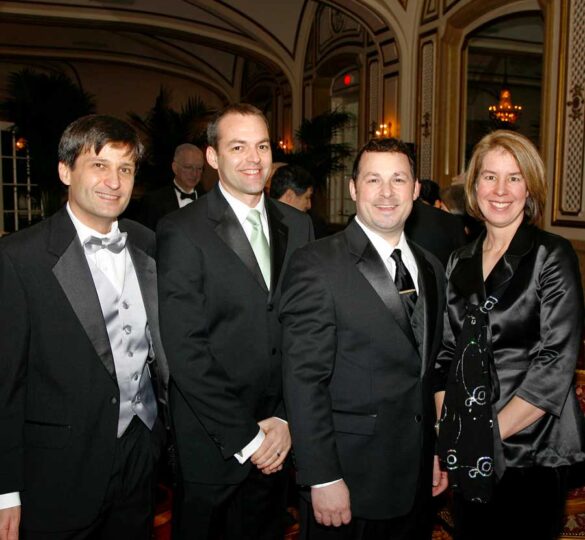Catalyst for a Cure Identifies Key Early Events in Glaucoma
During the year 2009, the investigators of the Catalyst for a Cure (CFC1) consortium worked together to probe how retinal ganglion cells are damaged and decline in glaucoma.

2009 was the ninth year of the Catalyst for a Cure (CFC1) collaborative research program, funded exclusively by the Glaucoma Research Foundation through a matching grant from the Melza M. and Frank Theodore Barr Foundation. CFC research is laying the groundwork for strategies that could lead to new diagnostics or treatments for glaucoma.
The group has targeted several key areas in their studies. CFC investigators have found that non-neural cells known as glia become recruited at early stages of the disease and may influence the decline of retinal ganglion cells.
By blocking signals that lead to the activation of one glial cell type known as astrocytes, it was found that abnormal glial activation can be detrimental to retinal ganglion cell function. The team has developed sophisticated tools to track the behavior of astrocytes and another cell type, microglia, and test their role in retinal ganglion cell survival. Their goal is to distinguish glial signals that are detrimental from those that may promote survival.
Within the retinal ganglion cells, the CFC has found abnormal accumulation of a specific protein, as has been found for other neurodegenerative diseases. The accumulated protein could have either toxic or protective effects, but early studies suggest that the protein aggregates may play a protective role in preserving retinal ganglion cells. Experiments are underway to directly test this idea in various models of glaucoma.
By tracing the progression of the disease, CFC researchers have identified key events that begin degeneration. Early in the disease, results show that loss of communication between the optic nerve and the brain may arise from dysfunctional processing of metabolic by-products and poor transport of energy packets from the retina to the brain. Other studies show that while the optic nerve is stressed, other mechanisms compensate to maintain as much structure in the nerve as possible. These mechanisms may represent a new opportunity for therapeutics.
Overall, these studies highlight the complex nature of glaucoma, and how multiple interacting factors may ultimately lead to vision loss in this disease. By understanding the components that drive retinal ganglion cell decline, the CFC is working towards targeting the most critical steps in glaucoma pathology with the ultimate goal of developing a treatment or cure for the disease.
2009 was a successful and productive year on many fronts. Multiple manuscripts were published in peer-reviewed scientific journals, with several more in submission. Notably, a paper was published in Investigative Ophthalmology & Visual Sciences showing that retinal ganglion cells express pressure sensors that render them vulnerable to elevated pressure.
A study published in Glia provides a detailed analysis of how non-neuronal cells (glia) respond to injury of the optic nerve. Importantly, another paper published in Investigative Ophthalmology & Visual Sciences advanced the field by providing a new way of modeling glaucoma for experimental analysis. With additional manuscripts on the way, the CFC is helping advance our understanding of retinal degeneration in glaucoma.
The CFC has been sharing their findings with other investigators from around the world in a number of international forums. Members of the CFC were invited to present their work at the Optical Society of America, the Annual Meeting of the Association for Research in Vision and Ophthalmology, the World Glaucoma Congress, the UCSF Glaucoma Summit and the Lasker/IRRF Workshop for Innovation in Vision Science, as well as at several major research universities.
With these efforts the CFC is committed to uncovering pathways that can be targeted to slow or halt vision loss in glaucoma.
CFC1 Principal Investigators
David J. Calkins, PhDVice-Chairman and Director of Research;
Denis M. O’Day Professor of Ophthalmology and Visual Sciences, Neuroscience and Psychology
Director, Vanderbilt Vision Research Center
Vanderbilt Eye Institute, Nashville, Tennessee
The Calkins lab focuses on the mechanisms of neurodegeneration in glaucoma. Using systems, cellular and molecular approaches, they investigate how risk factors contribute to neurodegeneration and test new treatments. Dr. Calkins specializes in molecular mechanisms of the retina and optic nerve.
Philip J. Horner, PhD
Professor of Neuroregeneration, Institute for Academic Medicine
Scientific Director, Center for Neuroregeneration
Houston Methodist, Weill Cornell Medical College
Houston, Texas
The Horner lab is focused on neurodegeneration and neural regeneration in models of glaucoma and spinal cord injury. The lab established a reliable glaucoma model that helped the team to study and test hypotheses. Dr. Horner’s experience in spinal cord injury and glial cells, applied to glaucoma, led to new findings on the role of gliosis and oxidative stress in glaucoma.
Nicholas Marsh-Armstrong, PhD
Associate Professor, Department of Ophthalmology and Vision Science
University of California, Davis
Davis, California
The Marsh-Armstrong laboratory studies molecular mechanisms involved in gene regulation, development and disease of the central nervous system, focusing principally on the retina. Marsh-Armstrong has identified gamma-synuclein aggregates in glaucoma in the CFC model of glaucoma — an important finding relating glaucoma to other neurodegenerative diseases.
Monica L. Vetter, PhD
Professor and Chair, Department of Neurobiology and Anatomy
University of Utah
Salt Lake City, Utah
The Vetter lab is studying glaucoma at the molecular level to understand how genetics influence and determine the fate of neurons in the retina and central nervous system. Their goal is to reveal principles governing cell biology that will lead to new disease treatments. Dr. Vetter is committed to better understanding the role of microglia in retinal ganglion cell pathology in glaucoma.
First posted on May 26, 2010; Reviewed on May 20, 2022.